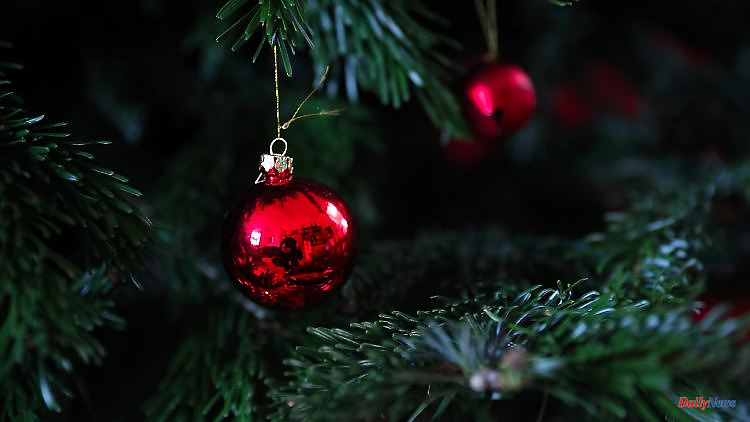Whether paradise, Christmas or Christmas tree: the conifers decorated with balls, stars and figures have become indispensable at Christmas. The plant has truly earned the title "Evergreen of hearts". But in the past not only more tinsel was announced, but also later decoration.
Oh Christmas tree, oh Christmas tree, how early are your buyers: millions of households in Germany set up the Christmas tree much earlier than was the tradition here in decades past. Weeks before the festival, there are no longer just trees with lights on Christmas markets, in shops, offices or public foyers, but also in living rooms, i.e. good rooms.
"The last weekend before the festival used to be the date when most people bought the tree, now it's more like the second or third Advent," says Eberhard Hennecke from the Federal Association of Christmas Tree and Greenery Producers (BVWE) to the German Press Agency . "The last decade has intensified this trend and really got it going, so that you get the Christmas tree very early and also throw it away early," adds Hennecke, the first BVWE chairman. In a certain way, Germany is perhaps just adapting to international customs. In the US, for example, many put up the Christmas tree just after Thanksgiving.
While in the 80s, 90s and noughties in the Federal Republic of Germany, the Christmas tree was mainly left up until Epiphany, i.e. January 6th, today it is often disposed of between the years or shortly after New Year's Eve, says Hennecke, who has been in his forest products business for more than 10 years has been growing Christmas trees for over 30 years. In the 1970s, putting up and decorating the Christmas tree on Christmas Eve was probably still the norm and an important part of the program. In any case, in Loriot's series of sketches "Christmas at Hoppenstedt's" from 1978, the father (Heinz Meier) says: "First the tree will be decorated, then Dicki will recite a poem, then we'll bring in the presents, then we'll watch the Christmas show on the first Program on, then we unpack, and then we'll make ourselves comfortable..."
A survey by the "Statista" portal recently revealed that only 12 percent of Christmas tree buyers are waiting until December 24 to set up the tree. On the other hand, more than half of those surveyed set up the tree in early to mid-December. 33 percent of those surveyed place and decorate the Christmas tree "a few days before Christmas Eve".
Christmas tree producer Hennecke in Sundern in the Hochsauerland says: "There used to be more patience during the Advent season, but today you live into the Christmas festival for weeks." In addition, the corona pandemic and the policy of contact restrictions in recent years have strengthened the desire for a cozy home in many people and also led to wanting to make it nice with a tree in a small community in good time. Since there are obviously difficult times, he sees no end to this need, says Hennecke.
Only recently, a representative survey by the opinion research institute YouGov on behalf of the German Press Agency showed that more than half of consumers would like to spend less around Christmas this year in view of the high energy and food prices. In addition to considering investing less money in gifts or food, this also includes the resolution to forgo a Christmas tree in 2022 or at least to buy a smaller one.
The tree prices for Christmas trees this year will probably remain at about the same level as last year. However, that could change in 2023, partly because there is a lack of staff and more and more producers could stop. So far, Germany is the largest Christmas tree producer in Europe. Every year around 27 million Christmas trees are sold in Germany with a turnover of between 500 and 550 million euros.
Paradise tree, sugar tree, light tree, Christmas tree, fir tree - the Christmas tree has gone through many stages of development.
Paradise tree: The origin of the Christmas tree goes back to the paradise play that was performed in the Middle Ages before the Christmas nativity play. A fir tree was chosen as the tree of paradise because it was still green in winter. Red apples were hung on the branches, from which the Christmas tree balls developed.
Sugar tree: The medieval guilds took over the tree of paradise and over time converted it into a gift tree decorated with sweets. After the festival, this "sugar tree" was "flowered off" by the children.
Tree of Lights: In the 17th century, the Protestant nobility placed candles on the previously unlit tree. The gifts were now placed under the tree. Over time, the tree of lights was also adopted by the Protestant bourgeoisie and exported to America. In England, Queen Victoria's German husband, Albert of Saxe-Coburg and Gotha (1819-1861), was responsible for spreading the tree.
Christmas tree: Catholics were skeptical about the custom for a long time, and as late as 1896 a Catholic pastor mocked Protestantism as a "Christmas tree religion". It was only after 1900 that the tree was fully accepted in all classes and denominations and was now more often called the Christmas tree.
O Tannenbaum: One of the most famous Christmas carols is also dedicated to the Christmas tree: "O Tannenbaum" goes back to a Silesian folk song from the 16th century.
(This article was first published on Friday, December 02, 2022.)












